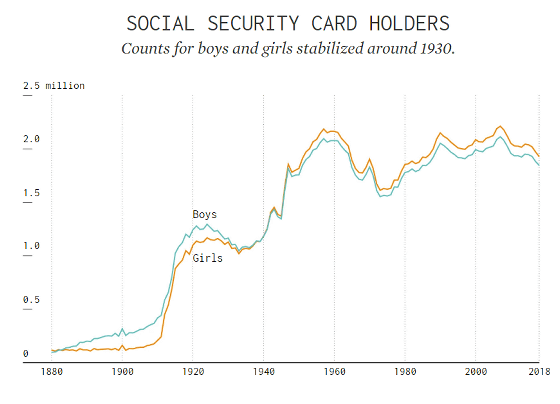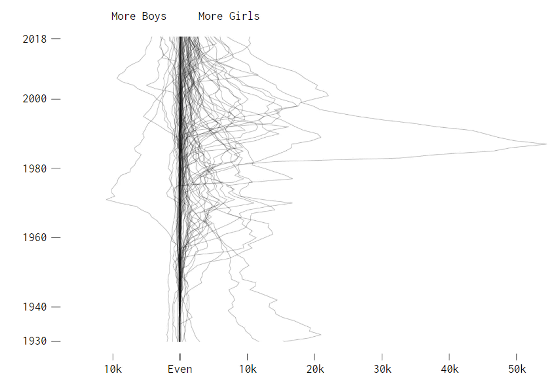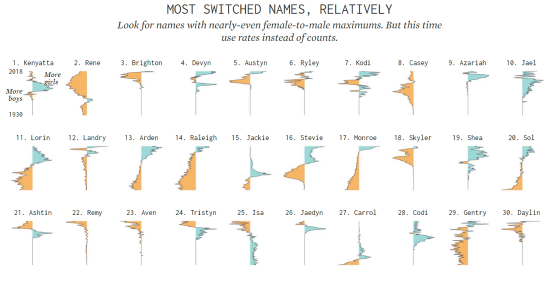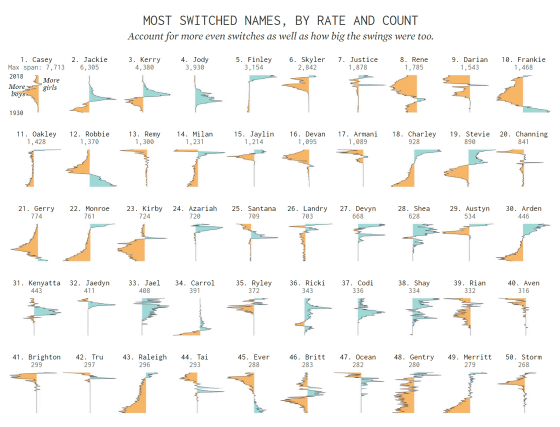A graph that clearly shows how `` boy's name '' and `` girl's name '' are reversed with changes in the times

by
It is often news that the names given to children change with the times, but in the United States, the names given to boys in the past have become popular with girls in recent years and vice versa. Since the US Social Security Bureau publishes children's names and their numbers every year as a data set , statisticians Nathan Yau and others used this data to visualize the transition of male and female names.
The Most Gender-Switched Names in US History | FlowingData
https://flowingdata.com/2019/08/28/gender-switched-names/
This data set is based on social security numbers, but not all Americans have social security numbers, so the data does not include all child names. In addition, the data is for people born after 1880, but before 1930, the percentage of men and women with social security numbers was significantly different, so Yau said the data of this survey was `` after 1930 '

Based on the above assumptions, Mr. Yau first defined the definition of “names whose genders were changed” as “the ratio of men and women after having said that“ half or more are boys or girls ”among children with one name” Was replaced. ' Examining these names from data from 1930 to 2018, it was found that 2987 of the 95,137 names in total corresponded. Visualizing these 2987 names looks like this. The graph on the left of the line labeled “Even” shows the number of boys, and the graph on the right shows the number of girls. The most mountainous name on the girl's graph is 'Ashley'.

Of these, the graphs with the peak count rate close to 1: 1 for men and women are as follows. The names 'Kelly', 'Jeremiah', 'Carol', 'Austin', 'Rene', 'Charlie', 'Jules' and 'Santana' are lined up. In other words, these names have a history of being used by boys and girls.

However, this graph uses raw numbers and does not consider the total number of names. In other words, the name “Rene” is not so popular because the name was not popular, but the possibility that the total number of girls born was simply large was not excluded.
Considering this point, the figure below shows the “reversed ratio of men and women” and “names that were popular at the time”. The numerical value of the graph is not the raw number but 'the percentage that the name was used' is used. It has been shown that the name “Kenyatta” was only popular with girls for the time being, and that the name “Austin” was popular with girls in recent years. In addition, if there is a sudden change between men and women like “Ashtin”, there are some like “Monroe” where the percentage of boys gradually decreases and switches to girls.

On the other hand, Mr. Yau said, “The possibility that the absolute number of Kenyatta was small was not excluded. Just because the ratio of only a few hundred Kenyatta was reversed between men and women, 'I can't call.' Therefore, in addition to comparing by ratio, Yau created the graph again, taking into account the “maximum number” in which the name was used.
As a result of taking into account that “the swing range was large” in addition to “the reversal of men and women”, the following graph was shown.

The top 10 names that changed their popular genders looked like this:
1: Casey
2: Jackie
3: Kelly
4: Jody
5: Finlay
6: Skyler
7: Justice
8: Rene
9: Dalian
10: Frankie
The time when the gender will change is different for each name. I do not know whether the sex used has changed completely or it has become unisex, but many things that were thought to be `` boy's thing '' `` girl's thing '' for a period are changing with the times It was an interesting result to show that.
Related Posts:
in Note, Posted by darkhorse_log







